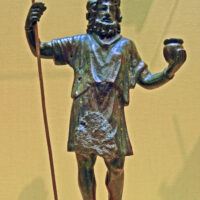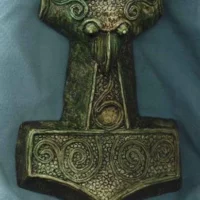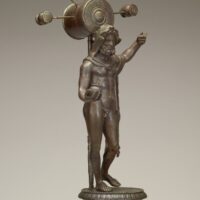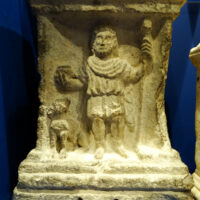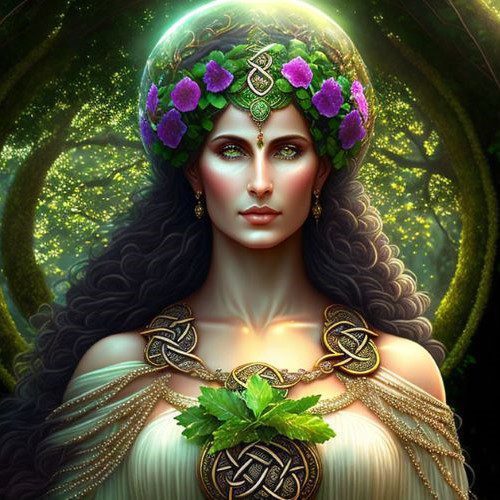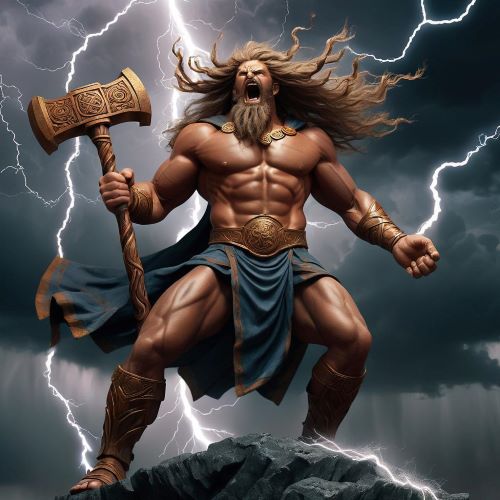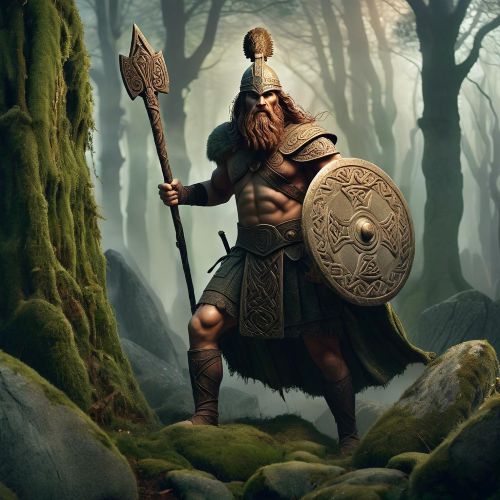Sucellus : God of Agriculture
Listen
At a glance
| Description | |
|---|---|
| Origin | Celtic Mythology |
| Classification | Gods |
| Family Members | Nantosuelta (Wife) |
| Region | France, Switzerland, Belgium, and Germany |
| Associated With | Agriculture, Boundaries, Prosperity |
Sucellus
Introduction
Sucellus, meaning “the good striker,” stands as a central figure in Celtic and Gallo-Roman mythology. Revered throughout Gaul and regions of the Roman Empire, he was widely recognized as a god of agriculture, abundance, protection, and the natural cycles of life and death. His worship was especially popular among rural communities, craftspeople, and those closely tied to the rhythms of the land. With deep associations that bridge fertility, craftsmanship, and the afterlife, Sucellus played a vital role in the spiritual and everyday lives of the ancient Celts. His legacy continues to attract interest from scholars and modern spiritual seekers exploring pre-Christian European beliefs.
Physical Traits
In visual representations, Sucellus is most often portrayed as a robust, mature man with a full beard, exuding both wisdom and strength. His defining attribute is a large, long-handled hammer or mallet, which represents not only physical power but also his dominion over fertility, protection, and boundaries. This tool was more than a weapon—it symbolized the generative force of agriculture and the authority to consecrate and safeguard land.
In his other hand, he frequently holds a vessel—usually a barrel, cauldron, or pot—linked with feasting, sustenance, and communal prosperity. These symbols underline his role as a provider, nourishing both body and spirit. Artistic depictions sometimes show him accompanied by a loyal dog, an emblem of guardianship and connection to the underworld, subtly reinforcing his link to the cycle of life and death.
Family
While Celtic mythology does not offer a detailed genealogy for Sucellus, his most significant mythological connection is with the goddess Nantosuelta. She is often depicted at his side, symbolizing the harmonious union between nature and domestic life. Associated with fertility, rivers, and hearth, Nantosuelta complements Sucellus’s more earthy and protective roles.
Together, they represent a divine pair concerned with the prosperity of both the land and the home. Though little is said about their offspring or extended divine kin, the strength of their partnership speaks volumes about how the Celts understood the balance between the wild and the cultivated. Some mythologists draw parallels between Sucellus and the Irish Dagda, suggesting a broader Indo-European theme of the father-god who nurtures life and guards the passage to death.
Other names
Sucellus was known by a variety of names and forms across the regions where he was worshipped. Variants such as Sucellos and Sucaleus reflect linguistic differences in Gaulish and other Celtic dialects, but the essential meaning of “good striker” remains constant. The etymology, drawn from the roots “su-” (good) and “cellus” (striker or hitter), emphasizes his positive and powerful nature.
With the Roman occupation of Gaul, Sucellus was frequently identified with Silvanus, the Roman god of forests and boundaries. This syncretic adaptation merged their roles as protectors of nature and rural communities. In some texts, especially those written from a Roman perspective, Sucellus was also equated with Dis Pater, a god of the underworld, reflecting his chthonic associations and reinforcing his stature as a guide between realms.
Powers and Abilities
Sucellus is a god of vast influence whose powers stretch across multiple domains. His authority over agriculture is central, as he governs the fertility of the land and ensures the cycle of planting and harvest continues without disruption. The striking of his mallet is symbolically tied to awakening the earth and bringing forth crops, an act that connects the spiritual with the practical needs of agrarian life.
He is also a guardian of boundaries—whether of fields, communities, or the metaphysical borders between life and death. His protective aspects extend to shepherds, farmers, craftsmen, and the underprivileged, showing his deep connection to everyday people rather than the elite or warrior class. The vessel he carries is often interpreted as a source of divine nourishment, linked with wine or ale, symbolizing the joys of communal celebration and the sacredness of feasting.
Some interpretations also place Sucellus in a chthonic context, where he takes on the role of a psychopomp, guiding souls to the afterlife. This role is supported by his association with canines, which were often connected to the otherworld in Celtic belief. The dual nature of his power—both life-giving and underworld guiding—shows a deity who exists at the threshold, balancing life, death, and rebirth.
Modern Day Influence
Though the worship of Sucellus declined with the spread of Christianity across Europe, his legacy lives on in modern interpretations of Celtic mythology and spiritual practice. In contemporary neo-pagan and Druidic circles, he is celebrated as a god of the land and harvest, often honored during seasonal festivals like Lughnasadh or the autumn equinox.
His image, particularly the striking figure with a hammer and cauldron, has inspired artists, writers, and musicians interested in reimagining ancient European traditions. The symbolism of his tools resonates with modern values—strength tempered with nurturing, and protection paired with generosity. These attributes align well with ecological and cultural movements that seek to revive lost connections to land, craftsmanship, and sustainable living.
Sucellus has also become a subject of academic exploration, particularly among scholars of Roman-Gallic syncretism and comparative mythology. His cross-cultural appeal and multifaceted identity make him a compelling figure for understanding how myths adapt and endure through changing times.
In popular culture, elements of Sucellus appear in fantasy literature, role-playing games, and media inspired by Celtic lore. Although he may not be as instantly recognizable as some Greco-Roman deities, his archetypal significance as a wise, earthy, and benevolent force continues to hold meaning for those drawn to ancient spiritual traditions.
Related Images
Source
Delamarre, X. (2003). Dictionnaire de la Langue Gauloise (2nd ed.). Éditions Errance.
Duval, P.-M. (1993). Les dieux de la Gaule. Presses Universitaires de France.
Green, M. (2003). Symbol and Image in Celtic Religious Art. Routledge.
Heichelheim, F. M., & Housman, J. E. (1948). Sucellus and Nantosuelta in Mediaeval Celtic Mythology. L’antiquité classique, 17(1), 305–316. https://doi.org/10.3406/antiq.1948.2845
PaganPages.org. (2024). Good God!: Sucellus
Wikipedia contributors. (2025). Sucellus. Retrieved from https://en.wikipedia.org/wiki/Sucellus
Frequently Asked Questions
What is lorem Ipsum?
I am text block. Click edit button to change this text. Lorem ipsum dolor sit amet, consectetur adipiscing elit. Ut elit tellus, luctus nec ullamcorper mattis, pulvinar dapibus leo.
What is lorem Ipsum?
I am text block. Click edit button to change this text. Lorem ipsum dolor sit amet, consectetur adipiscing elit. Ut elit tellus, luctus nec ullamcorper mattis, pulvinar dapibus leo.
What is lorem Ipsum?
I am text block. Click edit button to change this text. Lorem ipsum dolor sit amet, consectetur adipiscing elit. Ut elit tellus, luctus nec ullamcorper mattis, pulvinar dapibus leo.
What is lorem Ipsum?
I am text block. Click edit button to change this text. Lorem ipsum dolor sit amet, consectetur adipiscing elit. Ut elit tellus, luctus nec ullamcorper mattis, pulvinar dapibus leo.
What is lorem Ipsum?
I am text block. Click edit button to change this text. Lorem ipsum dolor sit amet, consectetur adipiscing elit. Ut elit tellus, luctus nec ullamcorper mattis, pulvinar dapibus leo.



